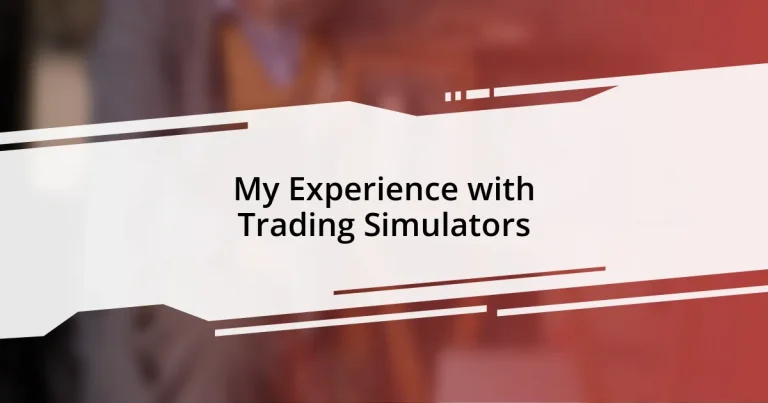Key takeaways:
- Trading simulators provide a risk-free environment to practice and refine trading strategies, helping users build confidence before real trading.
- Reflective practice after simulations enhances learning by allowing traders to analyze mistakes and improve decision-making skills.
- Choosing the right trading simulator involves assessing realism, asset variety, educational resources, and user community for a better learning experience.
- Emotional discipline and having a structured trading plan are crucial lessons learned throughout the simulator experience, emphasizing the importance of consistency in practice.
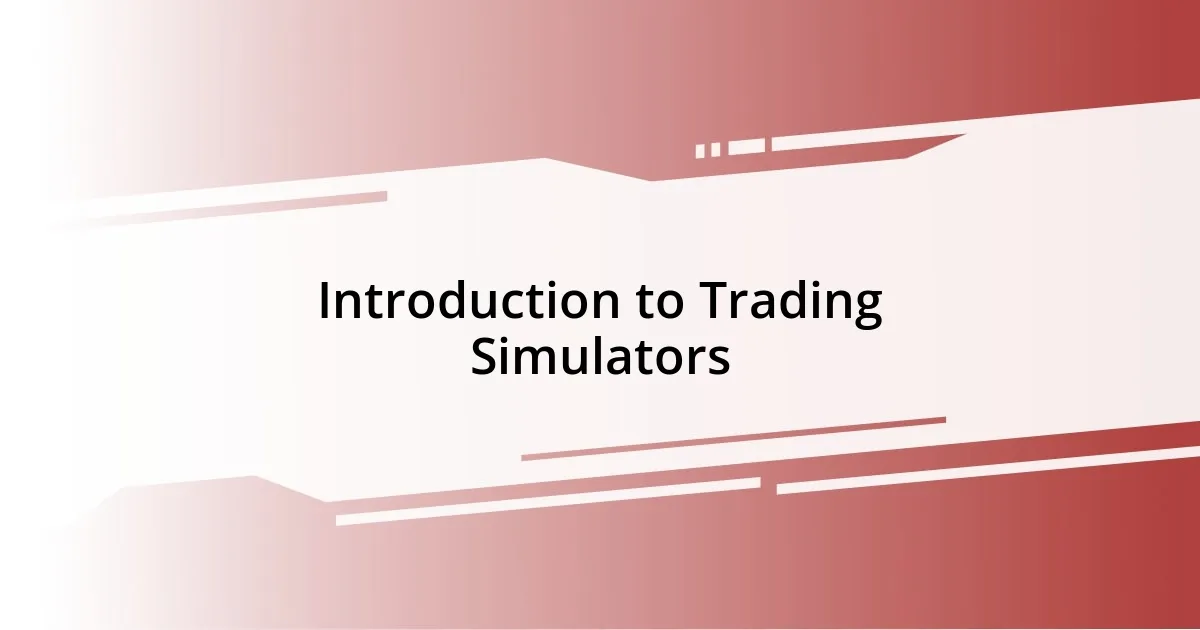
Introduction to Trading Simulators
Trading simulators are invaluable tools for anyone looking to dip their toes into the financial markets without the risk of losing real money. I remember my first encounter with a trading simulator; it felt like stepping into an entirely new world where I could experiment and learn at my own pace. The thrill of making trades—albeit fictitious—gave me a taste of the market dynamics, and I couldn’t help but wonder: What strategies would truly work when the stakes were high?
These simulators mimic real market conditions, allowing users to practice trades and test strategies in a safe environment. It’s more than just clicking buttons; it’s about understanding how different factors impact market movements. I often found myself reflecting on my decisions and questioning why I chose one path over another. Each playthrough was a lesson, one that helped me build confidence before I ever risked my hard-earned cash.
What intrigued me most was how these tools enabled me to avoid the pitfall of emotional trading. By simulating various scenarios, I discovered just how vital it is to remain detached and decision-focused. This kind of practice makes all the difference—imagine being able to experience the pressure of a market crash or the exhilaration of a big gain without facing real-world consequences! It’s truly eye-opening.
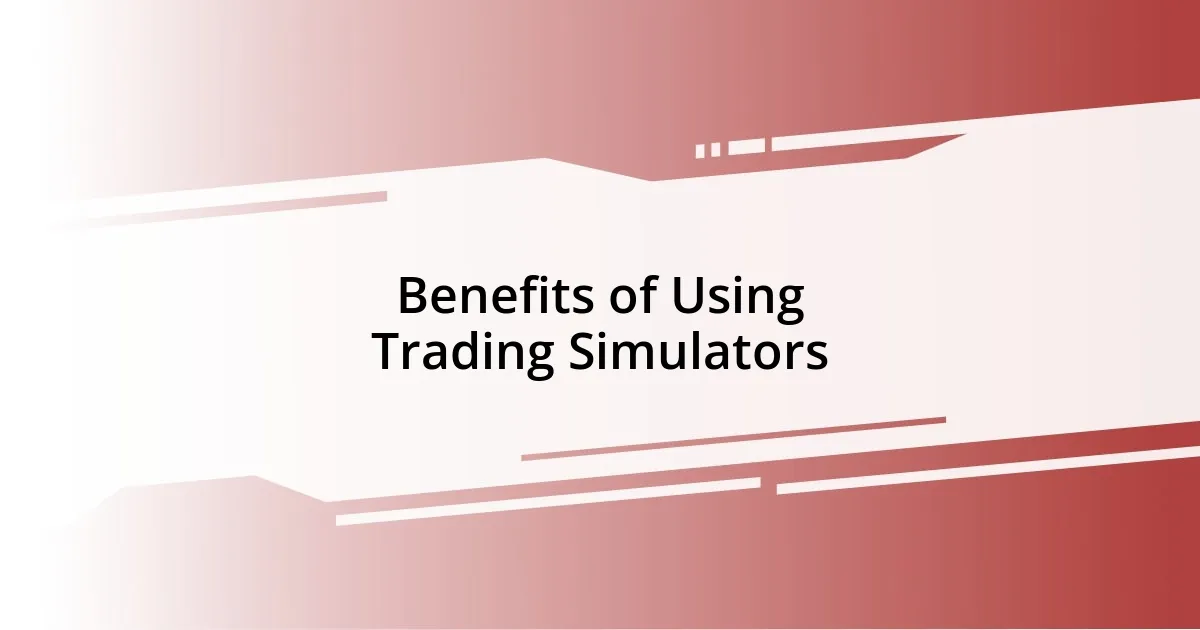
Benefits of Using Trading Simulators
Using trading simulators has allowed me to develop a strong foundation in market analysis without the risk of financial loss. I vividly remember the first time I simulated a volatile market scenario. Watching my virtual portfolio swing dramatically taught me the importance of staying calm under pressure, a lesson I took to heart for when I eventually entered live trading.
Another significant benefit is the ability to explore various trading strategies in real-time. I once dedicated an entire week to testing a scalping strategy. The instant feedback helped me realize that some approaches worked better for specific market conditions than others. This experimentation not only built my skills but also boosted my trading repertoire, giving me the confidence to adapt and evolve as a trader.
Finally, trading simulators provide an excellent opportunity for continuous learning. After each simulated session, I would analyze my performance and reflect on decisions made. This reflective practice helped me identify mistakes and refine my techniques, leading to steady improvement over time. Plus, there’s something immensely satisfying about fine-tuning your strategy without the financial risk that comes in the real world.
| Benefits | Details |
|---|---|
| Risk-free environment | Practice without financial loss. |
| Strategy experimentation | Test different trading strategies in real-time. |
| Performance analysis | Reflect on trades to improve future decisions. |
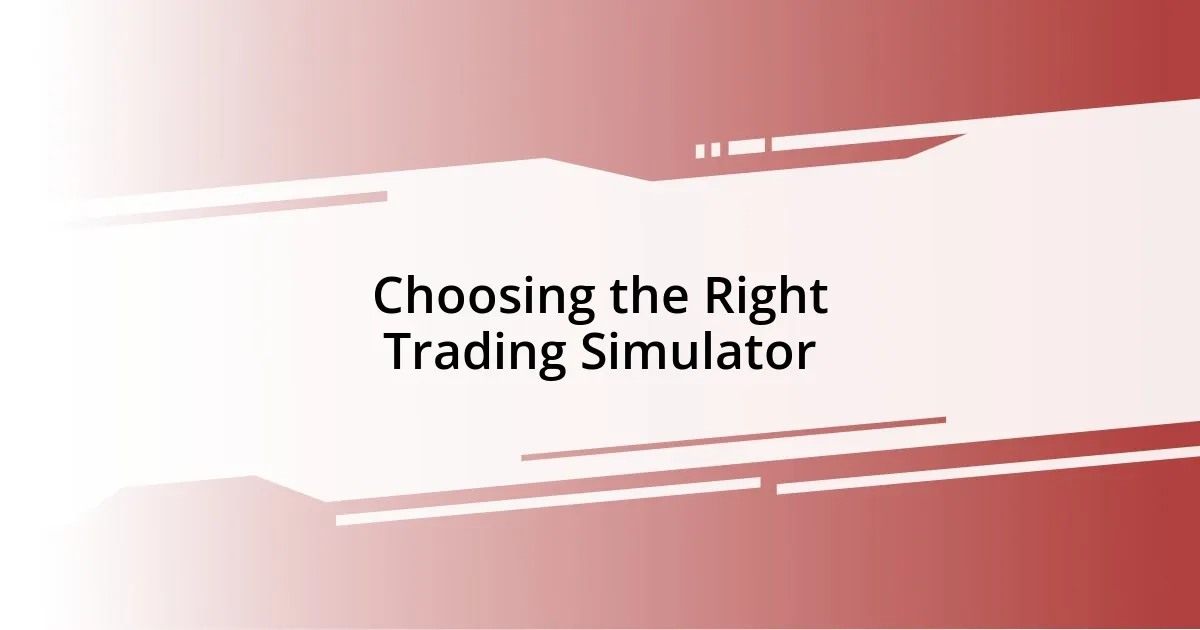
Choosing the Right Trading Simulator
When choosing the right trading simulator, I’ve found it crucial to consider the platform’s features and user interface. The first time I used a simulator, I was overwhelmed by unnecessary complexities. It wasn’t until I switched to a more user-friendly platform that everything clicked. A clean interface can make a world of difference, allowing you to focus on what truly matters: your trades.
To ensure you pick a simulator that suits your needs, here are some key factors to consider:
- Realism: Look for simulators that mimic real market conditions closely.
- Variety of Assets: Check if they offer a range of assets, from stocks to forex.
- Educational Resources: Does the platform provide tutorials or guides? This can be very beneficial.
- Community: A vibrant user community can enhance your learning experience.
- Customization: The ability to tailor your trading environment can help you focus on your specific interests.
In my experience, taking the time to evaluate these factors pays off immensely. I still remember finding a simulator that let me customize my dashboard; it transformed my learning curve. Each feature I tweaked felt like a step closer to mastering my trading skills.

Key Features to Look For
One of the key features to look for in a trading simulator is the realism of its market conditions. I recall struggling with a simulator that felt too detached from actual trading environments. The moment I switched to one that closely mirrored real market fluctuations, everything clicked. It made me wonder, “How can I really learn if I’m not facing challenges that I would encounter live?” That added layer of pressure helped sharpen my decision-making skills significantly.
Another important aspect is the range of assets available for trading. I remember my excitement when I discovered a simulator that allowed me to venture into commodities and forex on top of stocks; it opened up a whole new world of trading strategies I could test. This variety gave me the chance to understand how different markets react to economic news, making my learning journey so much richer. So, why limit yourself to just one market when you can explore multiple avenues to diversify your skills?
Don’t underestimate the value of educational resources within the simulator. Some platforms I tried in the past lacked sufficient guidance, which left me feeling lost at times. When I finally found one that offered comprehensive tutorials, it was like being handed a map on a challenging trek. I often think back to those moments of clarity I gained from a simple video tutorial or a structured lesson. They can be game-changers in your trading journey—how else would you build your knowledge base effectively?
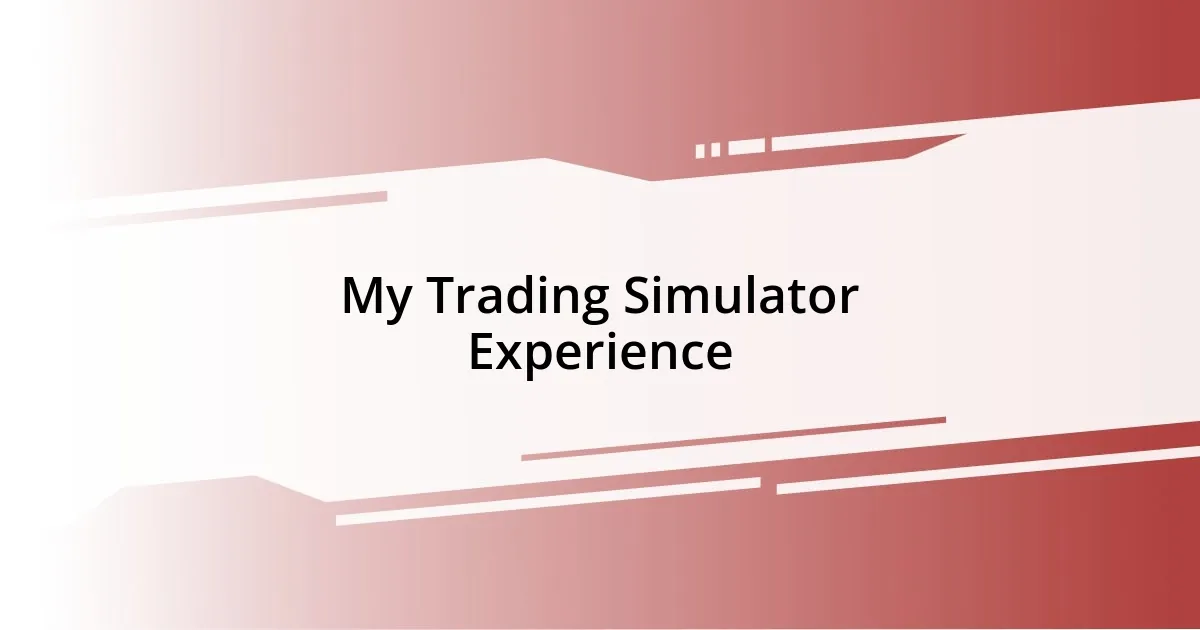
My Trading Simulator Experience
I vividly recall my first few weeks with a trading simulator; it felt like I was tossing darts in the dark. There were times I made hasty decisions, convinced I understood the market dynamics, only to watch my virtual portfolio plummet. This emotional rollercoaster taught me always to check my instincts against solid analysis, a lesson that echoes in my real-life trading today.
One simulator stood out for me, not just because of its features but because of the “aha” moments I experienced. It had a built-in analytics tool that allowed me to dissect my trades afterward. I can still picture the satisfaction I felt when I realized I could review my blunders and learn from them. It was empowering to turn past mistakes into stepping stones for future success.
Interaction with other users was another aspect that shaped my simulator experience. I remember joining a forum connected to one simulator where traders shared their journeys and strategies. The community felt like a support group; we celebrated victories and dissected losses together. It struck me how much insight I gained just by reading others’ experiences—after all, who doesn’t appreciate a friendly nudge in the right direction when navigating this complex world?
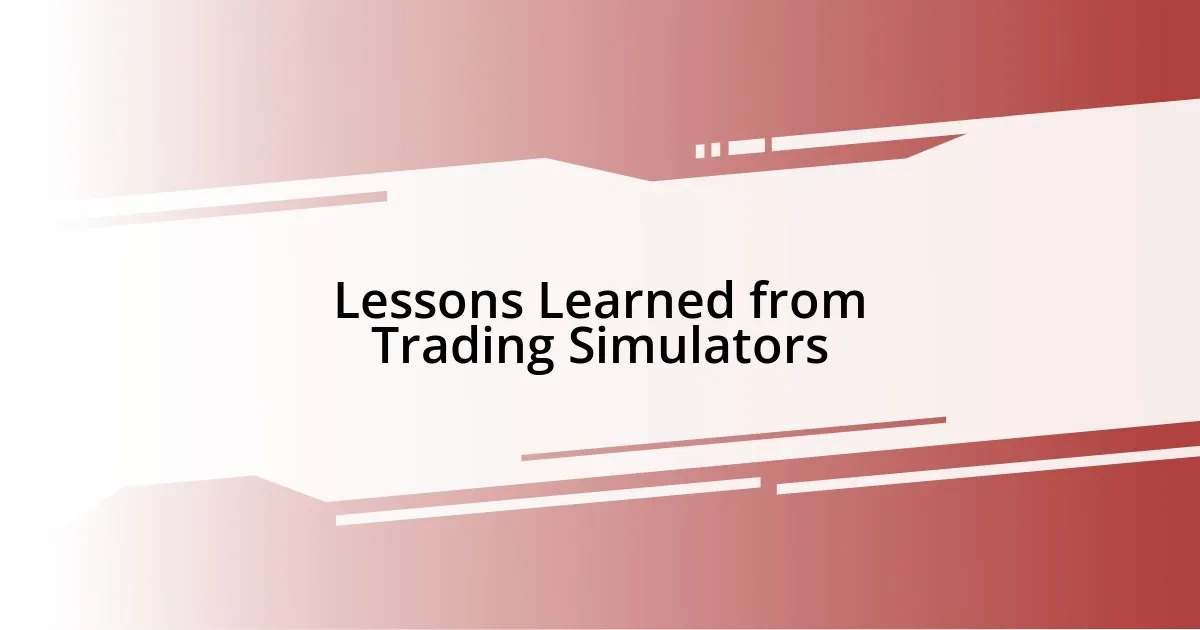
Lessons Learned from Trading Simulators
Experiencing trading simulators really opened my eyes to the importance of emotional discipline. I remember one particularly intense simulation where I panicked during a sudden market dip. Instead of sticking to my strategy, I sold off assets and realized later that I could have capitalized on the recovery. It was a stark reminder that learning to manage my emotions is just as critical as understanding market mechanics—how often do we let fear dictate our choices?
Another lesson I learned was the significance of developing a trading plan. At one point, I dove into a simulator without any structured approach, which led to chaos in my trades. Each time I analyzed my results, I found myself wondering why I hadn’t planned more rigorously. It was a lightbulb moment for me: a clear plan not only provides direction but also acts as a safety net during market fluctuations. How could I have overlooked such a fundamental aspect of trading?
Lastly, I discovered the power of consistency through my simulator journey. There were times when I’d play sporadically, dabbling here and there, but this lack of regular engagement only led to confusion. When I committed to a daily routine, everything changed. I began to see patterns in market behavior and made more informed decisions. Could it be that habitual practice is the key to mastering trading skills? I certainly believe so, and I wish I had realized it sooner.
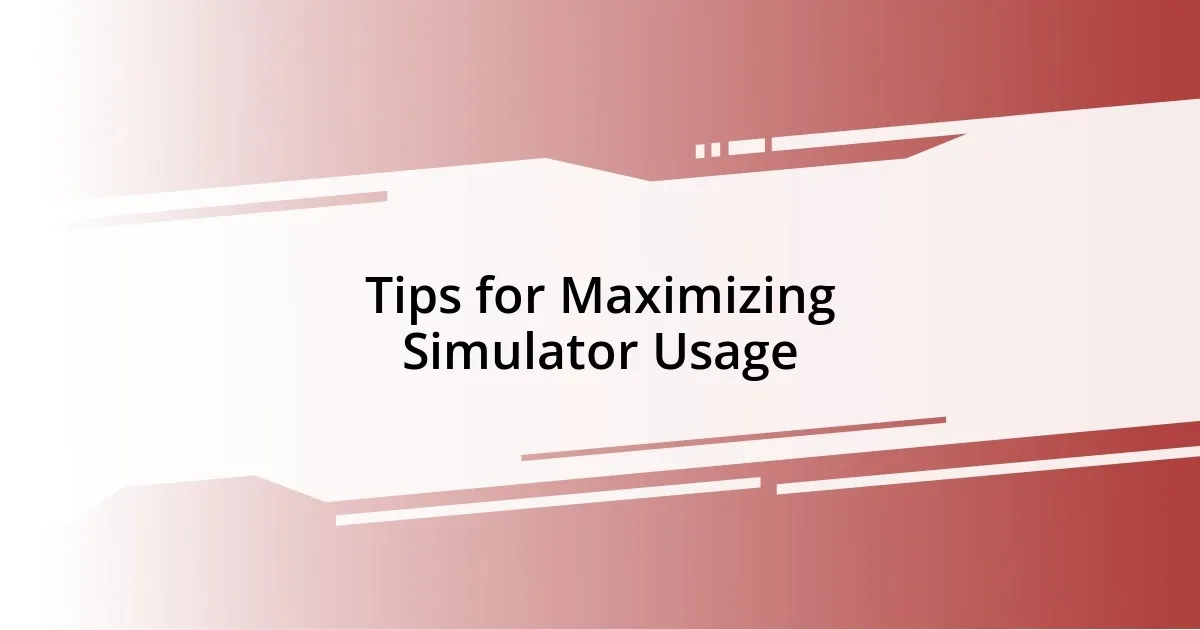
Tips for Maximizing Simulator Usage
When using a trading simulator, I found that treating it like a serious investment practice was pivotal. Initially, I approached it casually, but I soon realized that committing to my trades with focus made a significant difference. Have you ever noticed how being too relaxed can lead to careless mistakes? I did—so I started setting specific goals for each session, which created a sense of urgency and purpose.
One tip I can’t stress enough is to regularly review your trades. I made it a habit to reflect on my past sessions, often dedicating an entire day just to analyze what went right and what went wrong. This introspection reminded me of my high school basketball days, where we would watch game footage to improve. By seeing my trading decisions play out, I learned to identify patterns and emotional triggers that influenced my choices. Isn’t it amazing how this kind of feedback can shape someone’s understanding?
Additionally, I found that simulating various market conditions was incredibly beneficial. I remember experimenting with a downturn simulation, which, at first, felt intimidating. But pushing through that discomfort revealed some valuable insights about resilience and strategy adjustment. Have you ever faced a market fluctuation and felt lost? Simulating that feeling in a risk-free environment showed me the importance of staying calm and adapting my strategy—lessons I carry into my actual trading today.












